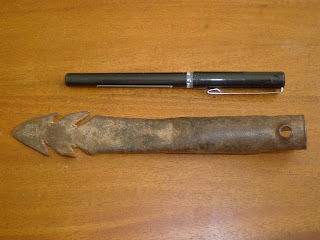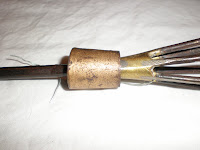Here are a few eBay auctions I watched (and unsuccessfully bid on) this weekend. I was outbid on each of them. I did pick up an old, used Papuan cooking utensil made with a coconut shell. I will describe that within the next few weeks.

A Kikuyu spear collected by Quaker missionaries in the 1920s. In perfect condition with a light-colored wood shaft. Sold for about $120.

A massive spear from the Sudan. In very good condition, including brass wire wrap near butt. Shaft is a little warped near butt. Sold for about $150. Shipping would have been prohibitively expensive.

A nice Ngbandi spear from the northern Congo. In excellent condition, with a nice blade and plenty of wire wrapping. I purchased a similar item from the same seller. The one I purchased (and thus, was able to afford) is missing a section of the butt. This complete spear sold for $78, which is not much more than I paid for mine.

A large Zulu assegai or iklwa from South Africa. Point is bound with leather. Appears complete. Sold for $175.

A Yakoma spear from the Congo. An interesting, very light-weight status symbol-type spear. Sold for $121.

A Ngbandi spear head. A strange, thin point with strong barbs; probably part of a status symbol-type spear like #5. It would have made a deadly thrown spear, however. Sold for about $50.

A Somali spear head. Small and light, with a decorative element at base of blade. Similar to the point i described
here. Sold for $39.

A spear head from the Congo. Rather crudely made, with a very large barb. A functional hunting weapon. Sold for $40.

An interesting spear head from Uganda. Solidly built and finely made, with two fullers like the Ethiopian points I described
here and
here. Sold for $40.

A Mossi spear head from Burkina Faso, West Africa. Nicely made for a West African piece, with a long shank and a narrow, willow-leaf shaped blade. Sold for $43.

An arrow point from the Congo. Appears quite old, and is nicely decorated with filed and chiseled elements. 5" overall. Crisp, symmetrical form. Recalls some of the points from the northern Philippines. Has an excellent patina. Sold for a pretty ridiculous $100, at least 2 or 3 times what it's actually worth.

A harpoon point from the Congo. A very graceful, delicate form with very strong barbs. Of a different form than the Congolese harpoon I have in my collection. Retains some of the vegetable fiber cord. Sold for $82.

A very nice Malagasy spear head and butt. Shape of point recalls shape of Sudanese spear (#2). A solid, functional piece with decorative brass inserts.
Kind of a discouraging lot of auctions, but maybe I'll have better luck next time. I would rather be surprised with a good deal on a good piece than have to pay what an item is actually worth (or more than it's worth.)


















































